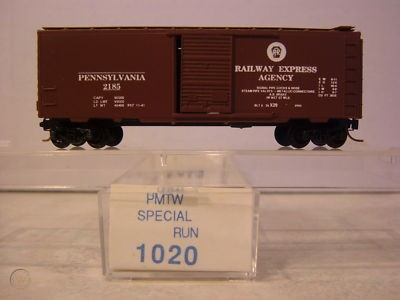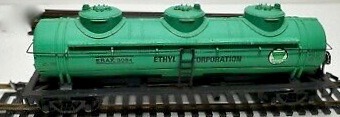Model Information: Precision Master first released this body style in kit form in 1986. Later on, they released the same body as a RTR (Ready-to-Run) model. In 2005, Red Caboose acquired this tooling from PM. Red Caboose has released this model in RTR form. When Red Caboose folded its doors, Fox Valley acquired the tooling and produced releases with the Fox Valley brand.
Different releases had some fairly important differences. Some Red Caboose releases have their coal loads permanently glued in place. This is a shame because the loads are pretty cheesy and if they are permanently affixed, then they cannot be replaced by high quality third party loads such as are made by Hay Brothers. Trucks and couplers vary as well. Early Red Caboose releases feature Micro-Trains trucks and couplers with MT's "standard" wheels. Later Red Caboose releases use cheaper Chinese knock-offs of the MT trucks (to save a few $ we assume). Fox Valley versions have body-mounted (MTL-knockoff) couplers using the new adapter designed by Trainworx.
These models are overall pretty good with a typical 1980s level of detail in the molding. The printing on all the manufacturers' models is quite good. However, the underframe is so awful it looks almost MELTED. Flipping it over and comparing it side-by-side with a 1960s vintage Roco-made hopper really shows off what a complete mess the underside of this car is. The Roco hopper is not just a little, but a LOT superior in terms if the molding. Also, let us be clear, for the models that include loads, these included loads are only a small step up from trash. An early 1960s coal load from an Arnold car looks better! If you are going to run these, make sure you only buy ones that do not have their loads glued in and be prepared to shell out some cash for a Hay Brothers (or equivalent) high quality N Scale load.
Different releases had some fairly important differences. Some Red Caboose releases have their coal loads permanently glued in place. This is a shame because the loads are pretty cheesy and if they are permanently affixed, then they cannot be replaced by high quality third party loads such as are made by Hay Brothers. Trucks and couplers vary as well. Early Red Caboose releases feature Micro-Trains trucks and couplers with MT's "standard" wheels. Later Red Caboose releases use cheaper Chinese knock-offs of the MT trucks (to save a few $ we assume). Fox Valley versions have body-mounted (MTL-knockoff) couplers using the new adapter designed by Trainworx.
These models are overall pretty good with a typical 1980s level of detail in the molding. The printing on all the manufacturers' models is quite good. However, the underframe is so awful it looks almost MELTED. Flipping it over and comparing it side-by-side with a 1960s vintage Roco-made hopper really shows off what a complete mess the underside of this car is. The Roco hopper is not just a little, but a LOT superior in terms if the molding. Also, let us be clear, for the models that include loads, these included loads are only a small step up from trash. An early 1960s coal load from an Arnold car looks better! If you are going to run these, make sure you only buy ones that do not have their loads glued in and be prepared to shell out some cash for a Hay Brothers (or equivalent) high quality N Scale load.
Prototype History: The 1960s brought about a growth in car size (and capacity). Railroads that transported coal moved away from the older 2-bay 55-ton USRA standard to newer railcars. The Ortner Rapid discharge car has a capacity of 100 tons. Over 10,000 cars of this kind were produced. Robert Ortner and a team of engineers created the rapid-discharge door system in the early 1960s. The original unit train consists were operating for Muskingum Electric Railroad (now AEP) and the Missouri Public Service Co.
Unloading a train of rapid discharge cars takes 30 minutes to an hour as opposed to four hours or longer for other unloading systems. Southern developed the unit train concept in 1960. Unit trains shuttle back and forth between mines and power plants. The first unit trains, composed of aluminum gondolas, went to power plants with rotary dumping facilities. Today, Southern has 14 unit coal trains on line; six in immediate prospect; and several others in longer range planning. While passing over a 900-foot long trestle, rapid discharge cars unload their coal in motion. Doors in the bottom of the cars are activated electrically.
Trinity Industries Inc. purchased Ortner Freight Car in late 1986 and continues to develop the rapid-discharge system with both updated transverse and longitudinal door applications. Trinity currently offers aluminum hoppers featuring the RDVI and RDL door systems.
Unloading a train of rapid discharge cars takes 30 minutes to an hour as opposed to four hours or longer for other unloading systems. Southern developed the unit train concept in 1960. Unit trains shuttle back and forth between mines and power plants. The first unit trains, composed of aluminum gondolas, went to power plants with rotary dumping facilities. Today, Southern has 14 unit coal trains on line; six in immediate prospect; and several others in longer range planning. While passing over a 900-foot long trestle, rapid discharge cars unload their coal in motion. Doors in the bottom of the cars are activated electrically.
Trinity Industries Inc. purchased Ortner Freight Car in late 1986 and continues to develop the rapid-discharge system with both updated transverse and longitudinal door applications. Trinity currently offers aluminum hoppers featuring the RDVI and RDL door systems.
Item created by: Alain LM on 2022-02-28 06:36:22
If you see errors or missing data in this entry, please feel free to log in and edit it. Anyone with a Gmail account can log in instantly.
If you see errors or missing data in this entry, please feel free to log in and edit it. Anyone with a Gmail account can log in instantly.










